文章目录
1. 在STL中的map与set
在STL中,map和set都是使用的红黑树
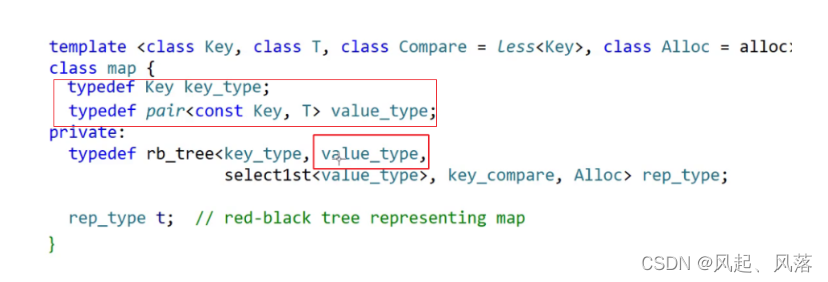

map与set在STL中实现是一样的
对于value_type,map的第二个模板参数是pair,而set的第二个模板参数是key
这样写是为了map和set使用同一颗红黑树去复用map和set
set < K > -> rb_tree<K,K>
map<K,V> - > rb_tree<K,pair<const K,V>>
第一个模板参数拿到单独K的类型,使用Find erase接口函数的参数是K
第二个模板参数决定了树的节点是 K 类型 or K V类型
2. 修改自己实现的红黑树
在上一篇文章中 ,实现了红黑树的插入等接口功能,
但是只能对于K V使用,修改模板参数使K或者 K V 都能调用
点击查看: 自己实现的红黑树
修改结构定义
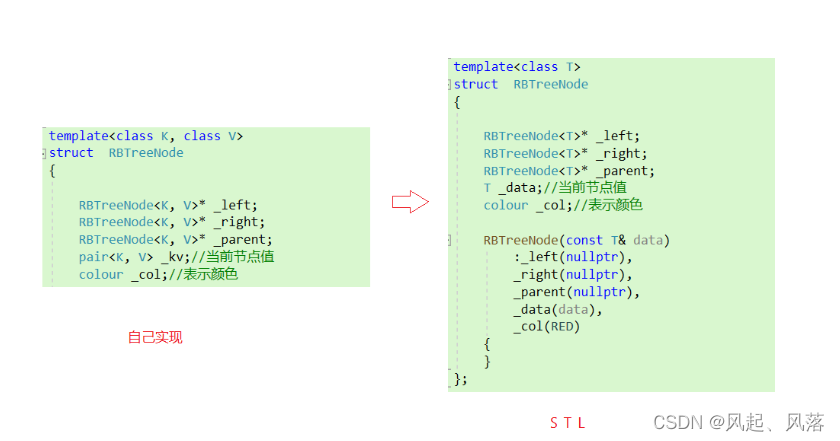
原本自己实现的红黑树 模板为 template<class K,class V>
第一个参数代表 key ,第二个参数 代表 value
把第二个参数 改为 T 即 template<class K,class T>
按照STL的写法,使用第二个模板参数决定树的节点
原本的kv包含K V ,但是由于要调用map 和set,所以不知道到底传过来的是什么
所以使用 模板类型的 data 代替

在结构定义时,为了让map与set都能调用同一颗红黑树,所以把模板参数改为T
当set要调用时,T变为<K,K>
当map要调用时,T变为<K,pair<const K,V>>

红黑树的insert中如何取到key
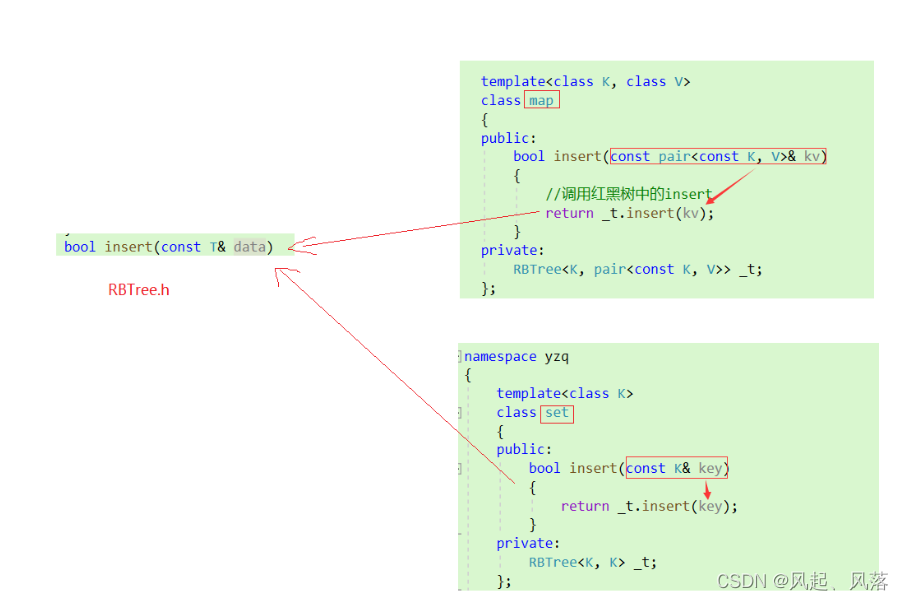
在insert中由于不知道data代表的是 pair还是K ,所以不能够取first
pair 虽然能够比较,但是不符合预期,所以要自己实现一个仿函数
我们要把key取出来,但是在红黑树中并不知道调用的是 set 还是map,无法知道T代表什么
但是在使用set或者map内部是知道的,所以 分别在map和set内部各自创建一个内部类,其中都写一个operator()
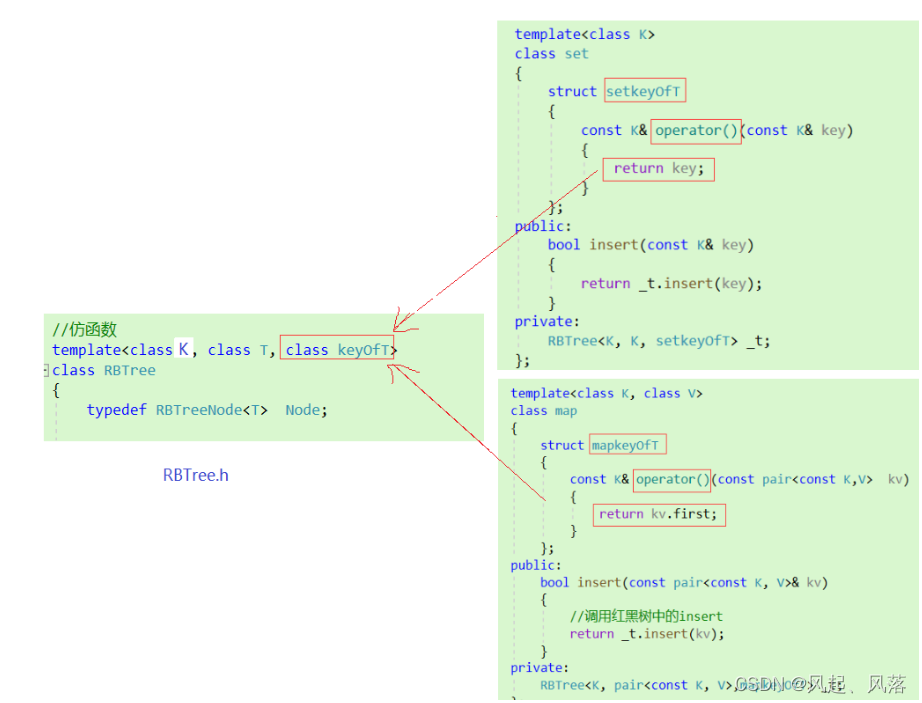
在函数模板中添加一个参数,即可找到对应map/set的key值
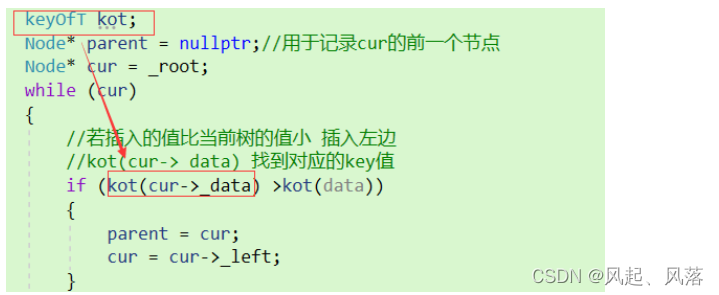
在红黑树内部,使用类实例化一个对象kot,通过kot去调用map/set 中相同的operator() ,取出对应的key值
迭代器
set/map的迭代器是红黑树内部的迭代器
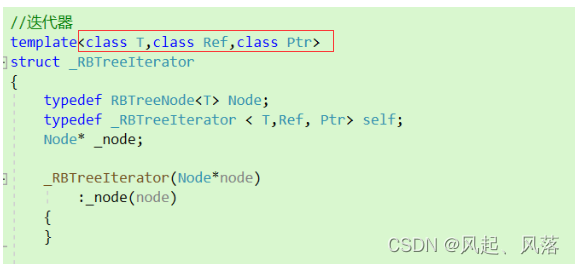


第二个模板参数Ref 第三个模板参数Ptr都是为了迭代器与const迭代器传参时有不同的参数存在,
从而区分普通迭代器与const迭代器
在list的模拟实现中有详细解释 关于 参数Ref 与Ptr 以及operator != -> * 的基本相似的使用
点击查看: 迭代器详细解释
operator++
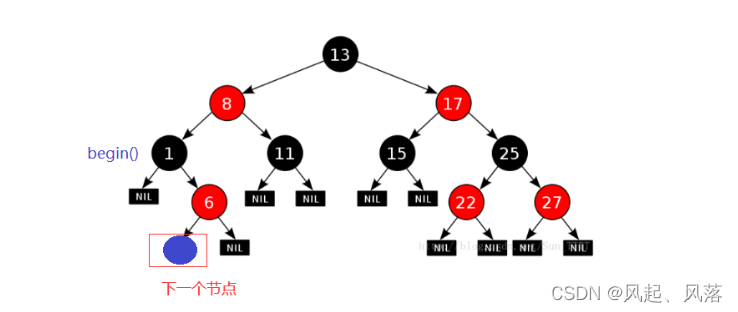
若当前右子树不为空,则下一个节点为右树的最左节点即蓝色节点
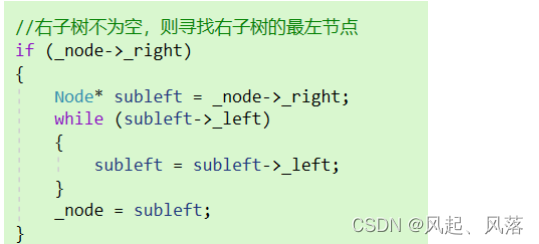

6的右子树为空,并且6作为1的右子树,需要继续往上寻找
将parent作为新的cur节点,把爷爷节点作为parent节点
6作为1的右子树,说明1已经遍历完了,所以把1及1的左右子树看作一个整体,1整体是8的左子树,
所以下一个节点返回8
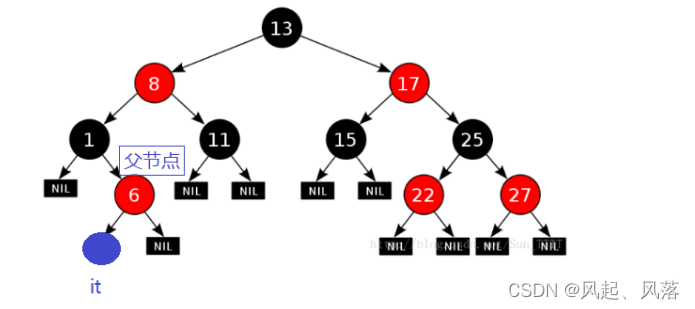
若右子树为空,并且孩子作为父节点的左子树,则直接把父节点返回即可
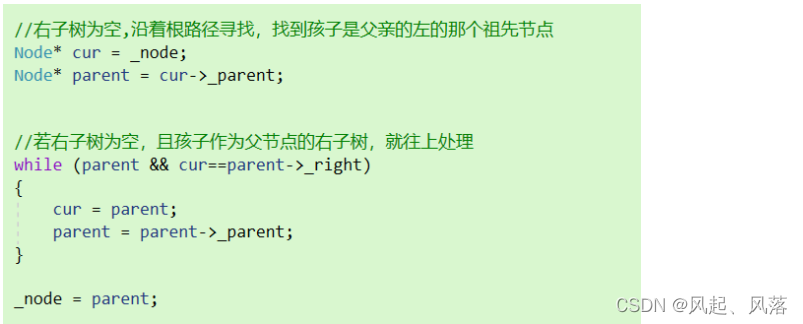
operator - -
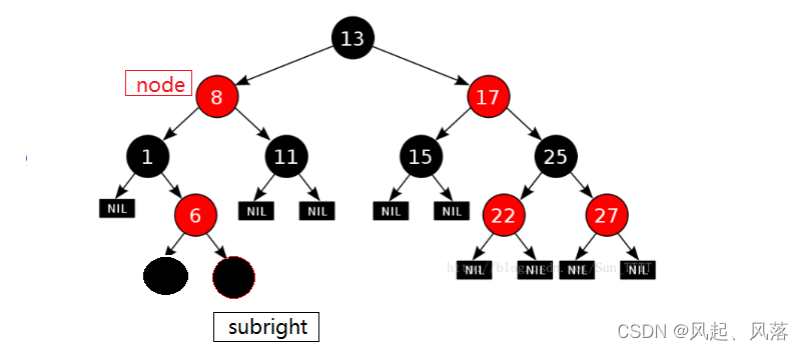
左子树若不为空,则寻找左子树的最右节点

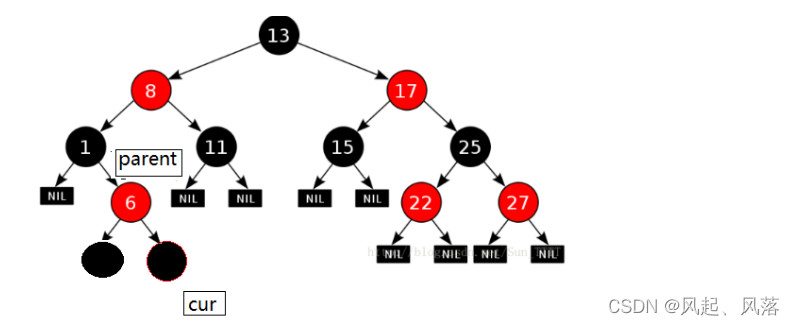
cur为当前节点,若cur的左子树为空,并且作为parent的右子树,则直接返回
parent节点
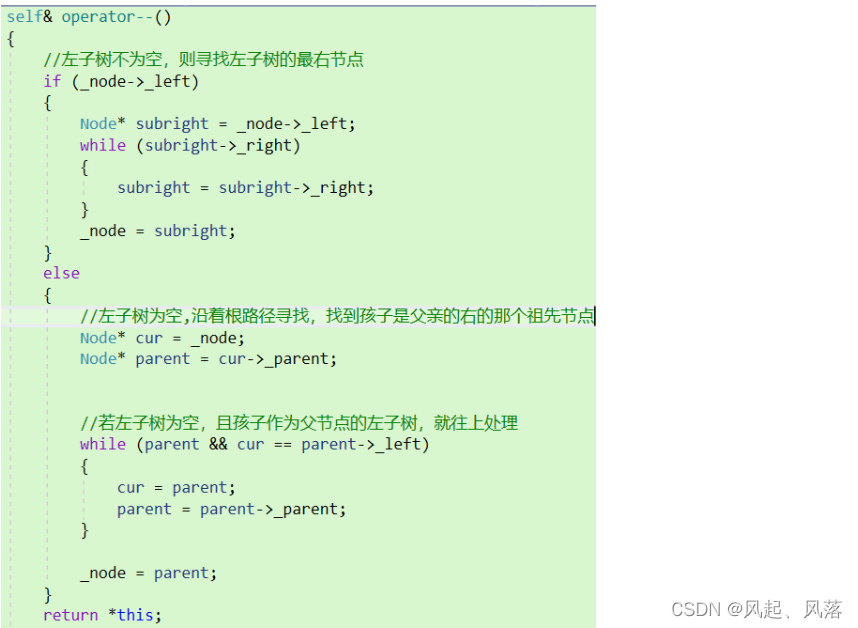
begin
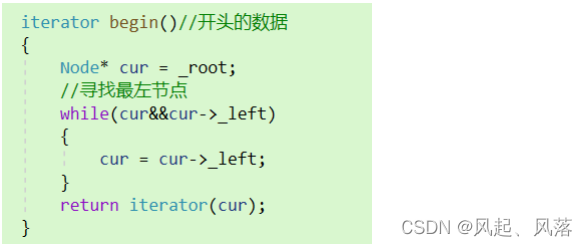
begin返回 的是开头的数据 即中序遍历的第一个 即最左节点
end

end返回最后一个数据的下一个 即nullptr
typename 问题

加入typename 是因为编译器无法识别RBTree<K, K,setkeyOfT>是静态变量还是类型
在set.h中,寻找到红黑树的迭代器,通过该迭代器调用对应的begin和end ,来实现set的begin和end
map 中 operator[]的实现

将insert的返回值设置成迭代器加布尔值
若插入成功,返回新插入节点的迭代器
若插入失败,返回已经有的节点的迭代器

在map中,通过设置好的insert返回值来达到[]的作用
operwator [] 详细的解析 ,点击查看迭代器部分 : map和set的使用
解决自己实现的迭代器的key值可以被修改问题
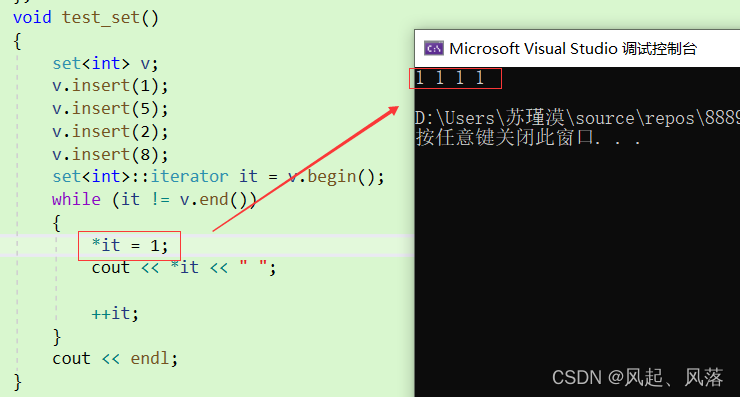
自己实现的迭代器的key值可以被修改,但是在STL实际上是不能被修改的

在STL中,普通迭代器和const迭代器都是const迭代器
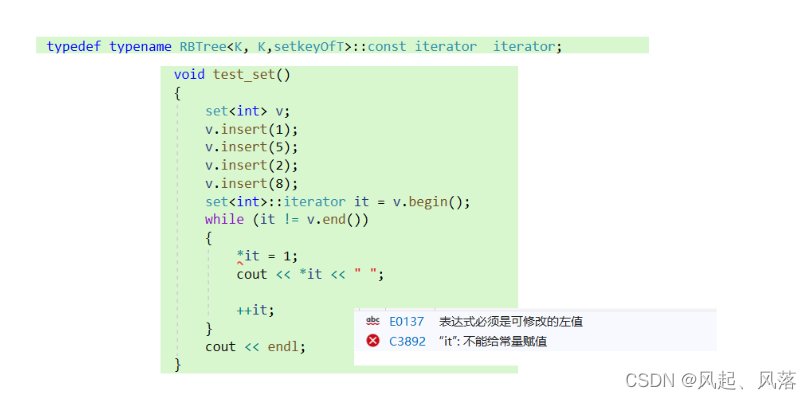
在set中同样做出相同的修改,即可解决问题

begin调用的是红黑树的普通迭代器,但是return返回的const迭代器
,所以正常运行时会报错
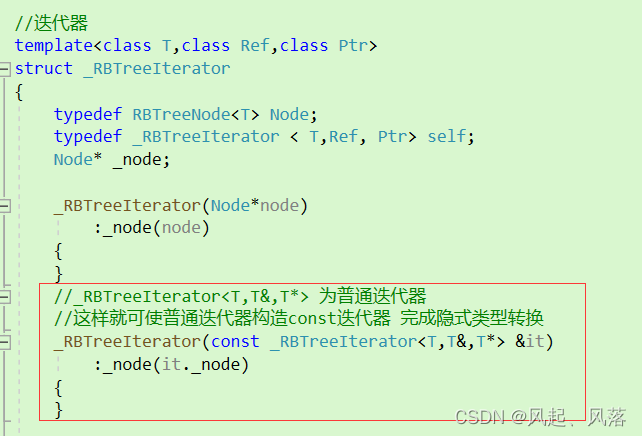
自己去实现一个普通迭代器类型,当类模板实例化为iterator时,则红框为拷贝构造
当类模板实例化为const_iterator时,通过发生隐式类型转换,使用普通迭代器构造const迭代器
3. 完整代码
RBTree.h
#pragma once
#include<iostream>
#include<cassert>
using namespace std;
enum colour
{
RED,//红色 默认为0
BLACK,//黑色 默认为1
};
template<class T>
struct RBTreeNode
{
RBTreeNode<T>* _left;
RBTreeNode<T>* _right;
RBTreeNode<T>* _parent;
T _data;//当前节点值
colour _col;//表示颜色
RBTreeNode(const T& data)
:_left(nullptr),
_right(nullptr),
_parent(nullptr),
_data(data),
_col(RED)
{
}
};
//迭代器
template<class T,class Ref,class Ptr>
struct _RBTreeIterator
{
typedef RBTreeNode<T> Node;
typedef _RBTreeIterator < T,Ref, Ptr> self;
Node* _node;
_RBTreeIterator(Node*node)
:_node(node)
{
}
//_RBTreeIterator<T,T&,T*> 为普通迭代器
//这样就可使普通迭代器构造const迭代器 完成隐式类型转换
_RBTreeIterator(const _RBTreeIterator<T,T&,T*> &it)
:_node(it._node)
{
}
Ref operator*()
{
return _node->_data;
}
Ptr operator->()
{
return &_node->_data;
}
bool operator!=(const self& s)
{
return _node != s._node;
}
self& operator++()
{
//右子树不为空,则寻找右子树的最左节点
if (_node->_right)
{
Node* subleft = _node->_right;
while (subleft->_left)
{
subleft = subleft->_left;
}
_node = subleft;
}
else
{
//右子树为空,沿着根路径寻找,找到孩子是父亲的左的那个祖先节点
Node* cur = _node;
Node* parent = cur->_parent;
//若右子树为空,且孩子作为父节点的右子树,就往上处理
while (parent && cur==parent->_right)
{
cur = parent;
parent = parent->_parent;
}
_node = parent;
}
return *this;
}
self& operator--()
{
//左子树不为空,则寻找左子树的最右节点
if (_node->_left)
{
Node* subright = _node->_left;
while (subright->_right)
{
subright = subright->_right;
}
_node = subright;
}
else
{
//左子树为空,沿着根路径寻找,找到孩子是父亲的右的那个祖先节点
Node* cur = _node;
Node* parent = cur->_parent;
//若左子树为空,且孩子作为父节点的左子树,就往上处理
while (parent && cur == parent->_left)
{
cur = parent;
parent = parent->_parent;
}
_node = parent;
}
return *this;
}
};
//仿函数
template<class K, class T, class keyOfT>
class RBTree
{
typedef RBTreeNode<T> Node;
public:
~RBTree()//析构
{
_Destroy(_root);
_root = nullptr;
}
public:
typedef _RBTreeIterator<T, T&, T*> iterator;
typedef _RBTreeIterator<T, const T&, const T*> const_iterator;
iterator begin()//开头的数据
{
Node* cur = _root;
//寻找最左节点
while(cur&&cur->_left)
{
cur = cur->_left;
}
return iterator(cur);
}
iterator end()//最后一个数据的下一个
{
return iterator(nullptr);
}
const_iterator begin()const //开头的数据
{
Node* cur = _root;
//寻找最左节点
while (cur && cur->_left)
{
cur = cur->_left;
}
return const_iterator(cur);
}
const_iterator end()const//最后一个数据的下一个
{
return const_iterator(nullptr);
}
Node* Find(const K & key)//查找
{
Node* cur = _root;
keyOfT kot;
while (cur)
{
//kot(cur->_data) 取出当前的key值
//_data 有可能为 K 或者 pair类型
if (kot(cur->_data) > key)
{
cur = cur->_left;
}
else if (kot(cur->_data) < key)
{
cur = cur->_right;
}
else
{
return cur;
}
}
return nullptr;
}
pair<iterator,bool> insert(const T& data)
{
if (_root == nullptr)
{
_root = new Node(data);
_root->_col = BLACK;//若刚插入一个节点,则该节点颜色是黑色
return make_pair(iterator(_root),true);
}
keyOfT kot;
Node* parent = nullptr;//用于记录cur的前一个节点
Node* cur = _root;
while (cur)
{
//若插入的值比当前树的值小 插入左边
//kot(cur->_data) 找到对应的key值
if (kot(cur->_data) >kot(data))
{
parent = cur;
cur = cur->_left;
}
//若插入的值比当前树的值大 插入右边
else if (kot(cur->_data)< kot(data))
{
parent = cur;
cur = cur->_right;
}
else
{
//若插入的值,在树中有相同的值 ,则插入失败
return make_pair(iterator(cur), true);
}
}
cur = new Node(data);
Node* newnode = cur;
//再次判断parent当前节点值与插入值大小
if (kot(parent->_data) > kot(data))
{
parent->_left = cur;
}
else
{
parent->_right = cur;
}
//cur的上一个节点即为 刚才的记录cur前一个节点的parent
cur->_parent = parent;
//当父节点不为NULL并且父节点为红色
while (parent != nullptr && parent->_col == RED)
{
Node* grandfather = parent->_parent;//爷爷节点
//若父节点为爷爷节点的左子树,则unlce为爷爷节点的右子树
if (grandfather->_left == parent)
{
Node* uncle = grandfather->_right;
// g
// p u
// c
//情况1:u存在并且为红,直接变色即可,并继续往上处理
if (uncle && uncle->_col == RED)
//若uncle节点为红色,将parent与uncle都置为黑色,爷爷节点置为红色
{
parent->_col = BLACK;
uncle->_col = BLACK;
grandfather->_col = RED;
//继续往上调整
cur = grandfather;
parent = cur->_parent;
}
//情况2+3:u不存在或者u存在且为黑,旋转+变色
else
{
//情况2
//g p c 作为一条直线 所以为单旋
// g
// p u
//c
if (cur == parent->_left)
{
//右旋转
RotateR(grandfather);
//最终p作为最终的根 为黑 g为红
parent->_col = BLACK;
grandfather->_col = RED;
}
//情况3
//g p c 作为一条折线 所以为双旋
// g
// p u
// c
else
{
//左单旋
RotateL(parent);
//右单旋
RotateR(grandfather);
//最终cur作为最终的根 为黑 g为红
cur->_col = BLACK;
grandfather->_col = RED;
//父节点继续保持红色
parent->_col = RED;
}
break;
}
}
else//grandfather->_right == parent
若父节点为爷爷节点的右子树,则unlce为爷爷节点的左子树
{
// g
// u p
// c
Node* uncle = grandfather->_left;
//情况1:u存在并且为红,直接变色即可,并继续往上处理
if (uncle && uncle->_col == RED)
//若uncle节点为红色,将parent与uncle都置为黑色,爷爷节点置为红色
{
parent->_col = BLACK;
uncle->_col = BLACK;
grandfather->_col = RED;
//继续往上调整
cur = grandfather;
parent = cur->_parent;
}
//情况2+3:u不存在或者u存在且为黑,旋转+变色
else
{
//情况2
//g p c 作为一条直线 所以为单旋
// g
// u p
// c
if (cur == parent->_right)
{
//左旋转
RotateL(grandfather);
//最终p作为最终的根 为黑 g为红
parent->_col = BLACK;
grandfather->_col = RED;
}
//情况3
//g p c 作为一条折线 所以为双旋
// g
// u p
// c
else
{
//右单旋
RotateR(parent);
//左单旋
RotateL(grandfather);
//最终cur作为最终的根 为黑 g为红
cur->_col = BLACK;
grandfather->_col = RED;
}
break;
}
}
}
//为了避免grandfather节点正好为根时,会被更新成红色的情况
_root->_col = BLACK;
return make_pair(iterator(newnode), true);
}
void inorder()//中序遍历
{
_inorder(_root);
cout << endl;
}
//判断一颗二叉树是否为红黑树
bool isbalance()
{
//检查根是否为黑
if (_root && _root->_col == RED)
{
cout << "根节点颜色是红色" << endl;
return false;
}
//连续的红色节点
return _check(_root, 0);
}
private:
void _Destroy(Node*root)//销毁
{
if (root == nullptr)
{
return;
}
//后序遍历
_Destroy(root->_left);
_Destroy(root->_right);
delete root;
}
bool _check(Node* root, int blacknum)
{
if (root == nullptr)
{
//为空时,blacknum代表一条路径的黑色节点个数
cout << blacknum << " ";
return true;
}
//blacknum代表黑色节点的个数
if (root->_col == BLACK)
{
blacknum++;
}
//若当前节点为红 父节点也为红
if (root->_col == RED
&& root->_parent
&& root->_parent->_col == RED)
{
cout << "存在连续的红色节点" << endl;
return false;
}
//遍历整棵树
return _check(root->_left, blacknum) && _check(root->_right, blacknum);
}
void _inorder(Node* root)
{
if (root == nullptr)
{
return;
}
_inorder(root->_left);
cout << root->_kv.first << " ";
_inorder(root->_right);
}
void RotateL(Node* parent)//左单旋
{
Node* subR = parent->_right;
Node* subRL = subR->_left;
parent->_right = subRL;
if (subRL != nullptr)
{
subRL->_parent = parent;
}
Node* ppnode = parent->_parent;//记录parent的前一个节点
subR->_left = parent;
parent->_parent = subR;
if (ppnode == nullptr)//说明parent是根即代表整棵树
{
_root = subR;//subR作为新的根
_root->_parent = nullptr;//subR的父节点指向原来的parent,所以要置nullptr
}
else//说明旋转的是一部分,所以要跟ppnode相连接
{
if (ppnode->_left == parent)//若连接在左子树上
{
ppnode->_left = subR;
}
else//若连接在右子树上
{
ppnode->_right = subR;
}
subR->_parent = ppnode;//将subR父节点置为ppnode
}
}
void RotateR(Node* parent)//右单旋
{
Node* subL = parent->_left;
Node* subLR = subL->_right;
parent->_left = subLR;
if (subLR != nullptr)
{
subLR->_parent = parent;
}
Node* ppnode = parent->_parent;//记录parent的父节点
subL->_right = parent;
parent->_parent = subL;
if (ppnode == nullptr)//若旋转整棵树
{
_root = subL;
_root->_parent = nullptr;
}
else//若旋转整棵树的部分子树
{
if (ppnode->_left == parent)
{
ppnode->_left = subL;
}
else
{
ppnode->_right = subL;
}
subL->_parent = ppnode;//使subL的父节点为ppnode
}
}
private:
Node* _root = nullptr;
};
map.h
#pragma once
#include"RBTree.h"
namespace yzq
{
template<class K, class V>
class map
{
struct mapkeyOfT
{
const K& operator()(const pair<const K,V> & kv)
{
return kv.first;
}
};
public:
//加入typename 是因为编译器无法识别RBTree<K, K,setkeyOfT>是静态变量还是类型
typedef typename RBTree<K, pair<const K,V>, mapkeyOfT>::iterator iterator;
iterator begin()//复用红黑树的begin
{
return _t.begin();
}
iterator end()//复用红黑树的end
{
return _t.end();
}
public:
pair<iterator,bool> insert(const pair<const K, V>& kv)
{
//调用红黑树中的insert
return _t.insert(kv);
}
V& operator[](const K&key)
{
pair<iterator,bool>ret=_t.insert(make_pair(key, V()));
return ret.first->second;
}
private:
RBTree<K, pair<const K, V>,mapkeyOfT> _t;
};
void test_map()
{
map<int, int> v;
v.insert(make_pair(1, 1));
v.insert(make_pair(2, 2));
v.insert(make_pair(3, 3));
map<int, int>::iterator it = v.begin();
while (it != v.end())
{
cout << it->first << ":"<<it->second<<endl;
++it;
}
}
}
set.h
#pragma once
#pragma once
#include"RBTree.h"
namespace yzq
{
template<class K>
class set
{
struct setkeyOfT
{
const K& operator()(const K& key)
{
return key;
}
};
public:
//加入typename 是因为编译器无法识别RBTree<K, K,setkeyOfT>是静态变量还是类型
typedef typename RBTree<K, K,setkeyOfT>::const_iterator iterator;
typedef typename RBTree<K, K, setkeyOfT>::const_iterator const_iterator;
iterator begin()//复用红黑树的begin
{
return _t.begin();
}
iterator end()//复用红黑树的end
{
return _t.end();
}
public:
pair<iterator,bool> insert(const K& key)
{
return _t.insert(key);
}
private:
RBTree<K, K, setkeyOfT> _t;
};
void test_set()
{
set<int> v;
v.insert(1);
v.insert(5);
v.insert(2);
v.insert(8);
set<int>::iterator it = v.begin();
while (it != v.end())
{
cout << *it << " ";
++it;
}
cout << endl;
}
}